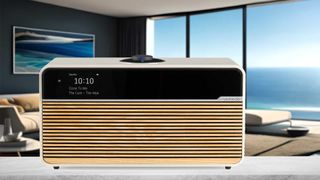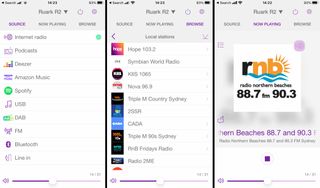
This review originally appeared in Sound+Image magazine, Australian sister publication to What Hi-Fi?. Click here for more information on Sound+Image, including digital editions and details on how you can subscribe.
Read What Hi-Fi?'s global, star-rated Ruark Audio R2 Mk4 review.
Rather than review the Ruark R2 Mk4 Smart Music System in our usual listening rooms, we decided to set it up in a master bedroom.
It’s that sort of product – ideal for a study or secondary space, and very much looking the part for either location with its modern take on a classic radio design.
We were glad we did this. It showed what an effect such a high-quality music maker can have on music listening habits, because the Ruark is just so easy to use, so easy to get playing with a single tap of the power button, that we reckon it must have quadrupled the amount of music we played in that space during its time. And that’s a recommendation in itself.
Design & build
There’s one important potential perception to correct here. It would be easy to look at the R2, see just a big old-style radio, and think, well, £439 / AU$899 doesn’t seem particularly cheap for a big radio.
But hold on a minute. The better comparison here is not with an old radio: it’s with the latest high-tech wireless speakers, such as those available as part of platforms like Sonos or HEOS.
Because the Ruark R2 has precisely those skills – it is not just a radio. It has wireless networking, direct streaming of services like Spotify, Deezer and Amazon Music, full access to global internet radio stations via its own app, a specific ‘podcast’ source, plus Bluetooth, which can stream anything else you want via your smart device of choice.
But Ruark’s R2 goes beyond the abilities of most wireless speakers in also including both FM analogue and DAB+ digital radio, something few wireless speakers include.
So what we actually have here is a high-specification streaming music system, boosted by full radio abilities (other than AM, which it doesn’t have).

We reckon the R2 has one more big advantage over rival streaming wireless systems. Let’s compare the R2 Mk4 with what you’ll get at the same sort of price from major wireless speaker brands. From Sonos, it would be the Sonos Five, at £499 / AU$799. From HEOS it would be either the Denon Home 250, which launched at £449 / AU$849 but is now available at around AU$600, or the Home 350, which launched at £599 / AU$1299 but has settled around AU$900.
Sonically competent as those units may be (and two of them are previous Sound+Image award-winners), they are boring featureless black or white boxes when compared with the gorgeous R2, with its polymer cabinet slightly tilted back, and highlighted by the slatted grille made of wood. Our review unit came in the light cream lacquer with an ash-wood grille (pictured), which drew praise from all those who saw it, while a darker ‘espresso’ with a walnut grille is also available.
And even though this latest R2 Mk4 has skimmed a few centimetres from the depth of its predecessor (better for window ledges and bookshelves, says Ruark) it is nevertheless larger in size at 34cm wide and 18cm high than either the Sonos Five or the lesser Denon. Yet it’s just such a lovely design that it’s a pleasure to have in the home, compared with a featureless modern box designed to hide rather than contribute to décor.
Another differentiation is the amplification technology within. While Sonos (and we’d guess Denon) uses Class D amplifiers, Ruark’s R2 has genuine traditional Class AB amplification to drive its stereo drivers, which are Ruark’s NS+ full-range design, backed by neodymium magnets. All of which bodes well for the last point of comparison – sound quality.
- Best internet radios – see What Hi-Fi?'s recommendations

Sound quality

Inputs: minijack analogue stereo, USB-C, Bluetooth, Wi-Fi: Spotify Connect, Amazon Music, Deezer,
Outputs: headphones
Drivers: 2 x Ruark NS+
Finishes: Light cream or espresso lacquers
Dimensions (hwd): 18.5 x 34 x 15cm
Weight: 2.9kg
Setting up the Ruark R2 Mk4 involves little more than plonking it down somewhere sturdy, and then using the top-mounted Rotodial to follow the initial on-screen set-up instructions.
The Rotodial has been Ruark’s control of choice ever since the company transitioned from making traditional box speakers to its latter-day focus on radios and music centres, which today range from little mono radios up to the substantial table-sized R7, described as a ‘Radiogram Refined!’
The Dial has a central rotary section, with the power button at the bottom and seven other buttons arrayed around the top. Play/pause is sensibly at the apex, and ‘back’ and’ forward’ are sensibly at the outside, leaving two spaces on either side for alarm, menu, source and preset. There are twin alarms available with options for weekday and weekend alarms; a sleep timer is also available in the app so you can drift off to your favourite night-time tunes.
Examining the connections at the attractive rear we noted two minijack sockets: one an analogue stereo line input, the other for plugging in a pair of minijack headphones. There’s also a USB-C socket which can be used for playback or for charging, but playback is, we think, limited to MP3s, and of course with a USB-C socket you can’t plug in a standard USB-A stick without an adaptor. Nor can you plug in, say, an iPad with a USB-C to USB-C cable. It simply doesn’t recognise the device, other than offering to charge it.
But for set-up, it’s pick your language, connect to Wi-Fi, check for a firmware update, and then pick a source – and we were listening to digital radio within a couple of minutes. For radio reception we needed the antenna extended, and it’s worth noting the height of this, should you extend it fully vertically, as it extends to roughly triple the R2 Mk4’s height.
Meanwhile, the display on the left of the R2’s top third had now illuminated to show us both the time and date or, once playing, the time and radio station/show, or the track, or whatever. It can show colour artwork for radio stations, but you have to specifically press the Rotodial for this, so you don’t see such logos in general use.
And now, the sound. We love the R2 Mk4’s sound, as we have previous Ruark tabletop music systems. They look like classic radios, and they’re able to sound like that – a rich woody sound, and one that remains rich even at quite low levels, thanks to Ruark’s use of adaptive EQ to put a tilt of bass into lower-level listening. So whether trickling out daytime radio as background music or being cranked up for something louder when entertaining or vacuuming, the R2 Mk4 can deliver in full.
- Best all-in-one systems – see What Hi-Fi?'s recommendations

It’s particularly well tuned for voices to sound engaging and real, both male and female, so that it’s also a great way to hear podcasts. For this, as for internet radio, the best way to find your way around is to download the Ruark’s control app, which is Undok (shown above), provided by Frontier (which presumably makes the streaming and radio platform within the R2).
Undok has been around for years, and Ruark has stuck with it. It’s attractive and clean, if fairly basic in its implementations, so that finding an internet radio station or podcast requires either a text search or browsing by genre/country, the method used since the dawn of internet radio. Even this could be a little sluggish, we found, but delays can be circumnavigated by putting your favourites into the eight preset slots available for each source. These can then be accessed directly from the Rotodial. Indeed since the Ruark turns on to whatever was previously playing, many users may never need to do more than press the power button to turn on the Ruark at their favourite station.
[UPDATE: Since our review, we see that Ruark is now recommending the Octiv app, rather than Undok. We're not sure why.]
For much of the time, that’s precisely what we did: we tuned the R2 Mk4 into a favourite station for FM, DAB+ and internet radio, and then we’d just wake up and hit the power button to have music flowing.
We note that while some Ruark music players use the Undok app for multiroom sharing to other Ruark devices, the R2 Mk4 has been left out of this useful loop, for reasons unstated.
Other than the app there’s no remote control provided, but one is available for around £15 / AU$35, and that has four useful direct-access preset buttons.
When pumping out the compressed radio streams of FM, DAB+ and many internet radio streams, the friendly sound of the Ruark R2 Mk4 might accentuate the bass thump of dance music a little too intrusively; some might even feel there’s a little too much upper bass in general, so that male voices can be a little too full.
There’s an easy fix for this in the app settings, as the R2 ships with its ‘Loudness’ circuit engaged. Turn it off and the volume drops dramatically, but raise it back up and you’ll enjoy a much cleaner sound: a more ‘modern’ sound, you might say.
Which way you go will be down to taste; we listened for two weeks with Loudness on and didn’t object, but once we’d found the option we tended to prefer it off.

There are also bass and treble controls, with eight presets available for those, so there are further ways to tune the tone to your preference. We didn’t need these, but they might be useful to counteract the effects of certain room positions, or to tweak certain material.
Finally, there is a hidden ‘3D sound’ option, which isn’t available through the app, only if you access settings using the Rotodial’s own menus. Turning this off clarifies the midrange and treble in particular, so is well worth hunting down. Once we’d found it, that stayed off too.
For some reason we couldn’t get Spotify to ‘see’ the Ruark, but we listened to our own music and streams from Apple Music sent from an iPad Pro via Bluetooth. We didn’t find a pop track we didn’t enjoy through the R4; the warm sound fills all rock and pop with richness and musicality.
It rolled out the twin basses opening Walk On The Wild Side, and did a lovely stereo job of the doo-de-doos. Leonard Cohen’s voice was one that sounded a tad too thick on the O2 live version of Tower Of Song, but was better with that ‘Loudness’ setting off.
Of course, the ultimate low octaves are missing, so that it won’t present a symphony orchestra like a real large hi-fi system, but tonally we think fans of acoustic music will love its sound (‘loudness’ on to boost the strength of lower strings) and we were able to drift away delightfully to its rendition of Mozart’s Symphony #25 (Neville Marriner, 1984).
It has its limits. Halfway up should be plenty loud enough for most occasions, and beyond that things can start to sound stressed pretty quickly, especially with complex music or heavy bass, though this happens less if you turn off those ‘loudness’ and ‘3D’ defaults.
When we cranked Peter Gabriel’s Panopticom, it was able to remain uncongested far louder with loudness off, while the vocals had better cut-through at every level with ‘3D Sound’ off as well.
Verdict
We love the Ruark R2 Mk4 both as a design and for the easy ways it brings access to music.
It’s not a party machine for going loud, and there are some default settings we’d like to be able to defeat or select more easily, but it’s a powerful alternative to more modern-looking wireless speakers, coming with all mod streaming options, as it were, yet presenting in a stylish retro design.
It’s a perfect all-in-one for secondary rooms, and for lovers of radio especially.
